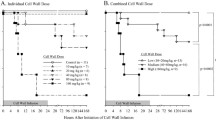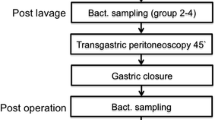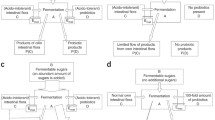Abstract
Obligate anaerobes are known to play a significant role in the development of intraabdominal abscesses. Much of our knowledge about these organisms is based on observations made using an animal model developed by this laboratory in 1974 [1,2]. The basic model system employs Wistar rats surgically implanted with an inoculum of intestinal contents from other rats. The inoculum is prepared in a manner which simulates the microbiologic parameters of the human colon. This is accomplished by placing rats on a diet of lean ground beef for two weeks and then harvesting, homogenizing and freezing aliquots of prepared intestinal contents for subsequent use. Following implantation of the intestinal contents, animals develop a characteristic bi-phasic infection. The first phase of the disease is peritonitis associated with positive blood and peritoneal cultures, death of approximately 50% of implanted animals, free flowing peritoneal exudates and an increase in peripheral white blood cell counts. Animals that survive the initial stage of disease appear to recover within five days of surgery. However, all surviving recipients of the intestinal content inoculum develop intraabdominal abscesses. This second phase of the disease is more chronic and is characterized by the presence of abscesses, adhesions and negative blood cultures. Abscesses contain a polymicrobic flora consisting of both obligate anaerobes and facultative species. The clinical end points for evaluation in this model are mortality and abscess formation, while microbiologic end points include blood, peritoneal and abscess cultures. The two phases of this disease are associated with distinctly different bacterial populations. During the early, acute peritonitis stage, Escherichia coli and other Gram negative organisms are numerically dominant and are responsible for the early mortality. The second more chronic stage of the disease, abscess formation, requires the presence of obligate anaerobes, such as Bacteroides fragilis. It has also been shown that abscess development in this model is associated with either a synergistic combination of obligate anaerobes and facultative species [3], or can be experimentally reproduced with the capsular polysaccharide of B.fragilis [4]. The unique properties of the capsular polysaccharide of B.fragilis and it’s role in both the induction and prevention of abscesses has been well documented in the literature [5–15]. It is the second phase of this experimental disease process that will be discussed in this chapter.
Similar content being viewed by others
References
Onderdonk AB, Weinstein WM, Sullivan NM, Bartlett JG, Gorbach SL. Experimental intra-abdominal abscesses in rats. II Quantitative bacteriology of infected animals. Infect & Immun 1974;10:1256–1259.
Onderdonk AB, Weinstein WM, Sullivan NM, Bartlett JG, Gorbach SL. Experimental intra-abdominal abscesses in rats. I. Development of Animal Model. Infect & Immun 1974;10:1256–1259.
Onderdonk AB, Bartlett JG, Louie T, Sullivan-Seigler N, Gorbach SL. Microbial synergy in experimental intra-abdominal abscess. Infect & Immun 1976;13:22–26.
Onderdonk AB, Kasper, D. L., Cisneros, R. L., Bartlett, J. G. The capsular polysaccharide of Bacteroides fragilis as a virulence factor: Comparison of the pathogenic potential of encapsulated and unencapsulated strains. J Infect Dis 1977;136:82–89.
Kasper DL, Hayes ME, Reinap BG, Craft FO, Onderdonk AB, Polk BF. Isolation and identification of encapsulated strains of Bacteroides fragilis. J Infect Dis 1977;136:75–81.
Kasper DL, Onderdonk AB, Bartlett JG. Quantitative determination of the antibody response to the capsular polysaccharide of Bacteroides fragilis in an animal model of intraabdominal abscess formation. J Infect Dis 1977;136:789–795.
Bartlett JG, Onderdonk AB, Louie T, Kasper DL, Gorbach SL. A review. Lessons from an animal model of intra-abdominal sepsis. Arch Surg 1978;113:853–857.
Onderdonk AB, Moon NE, Kasper DL, Bartlett JG. Adherence of Bacteroides fragilis in vivo. Infect & Immun 1978;19:1083–1087.
Kasper DL, Onderdonk AB, Polk BF, Bartlett JG. Surface antigens as virulence factors in infection with Bacteroides fragilis. Rev Infect Dis 1979;1:278–290.
Onderdonk AB, Kasper DL, Mansheim BJ, Louie TJ, Gorbach SL, Bartlett JG. Experimental animal models for anaerobic infections. Rev Infect Dis 1979;1:291–301.
Joiner KA, Gelfand JA, Onderdonk AB, Bartlett JG, Gorbach SL. Host factors in the formation of abscesses. J Infect Dis 1980;142:40–49.
Kasper DL, Onderdonk AB, Reinap BG, Linberg AA. Variations of Bacteroides fragilis with in vitro passage: Presence of an outer membrane-associated glycan and loss of capsular antigen. J Infect Dis 1980;142:750–756.
Kasper DL, Onderdonk AB. Infection with Bacteroides fragilis: Pathogenesis and immunoprophylaxis in an animal model. Scand J Infect Dis 1982;31 (Suppl):28–33.
Onderdonk AB, Markham RB, Zaleznik DF, Cisneros RL, Kasper DL. Evidence for T cell-dependent Immunity to Bacteroides fragilis in an intraabdominal abscess model.J Clin Invest 1982;69:9–16.
Shapiro ME, Onderdonk AB, Kasper DL, Finberg RW. Cellular immunity to Bacteroides fragilis capsular polysaccharide. J Exp Med 1982;155:1188–1197.
Kasper DL, Onderdonk AB, Crabb J, Bartlett JG. Protective efficacy of immunization with capsular antigen against experimental infection with Bacteroides fragilis. J Infect Dis 1979;140:724–731.
Zaleznik DF, Finberg RW, Shapiro ME, Onderdonk AB, Kasper DL. A soluble suppressor T cell factor protects against experimental intraabdominal abscesses. J Clin Invest 1985;75:1023–1027.
Onderdonk AB, Cisneros RL, Crabb JH, Finberg RW, Kasper DL. Intraperitoneal host cellular responses and in vivo killing of Bacteroides fragilis in a bacterial containment chamber. Infect Immun 1989;57:3030–3037.
Pantosti A, Tzianabos AO, Onderdonk AB, Kasper DL. Immunochemical characterization of two surface polysaccharides of Bacteroides fragilis. Infect & Immun 1991;59: 2075–2082
Tzianabos AO, Pantosti A, Baumann H, Brisson JR, Jennings HJ, Kasper DL. The capsular polysaccharide of Bacteroides fragilis comprises two ionically linked polysaccharides. J Biol Chem 1992;267:18230–18235
Tzianabos AO, Onderdonk AB, Rosner B, Cisneros RL, Kasper DL. Structural features of polysaccharides that induce intra-abdominal abscesses. Science 1993;262:416–419.
Tzianabos AO, Onderdonk AB, Smith RS, Kasper DL. Structure-function relationships for polysaccharide-induced intraabdominal abscesses Infection and Immunity. Infect & Immun 1994;62:3590–3593.
Tzianabos AO, Onderdonk AB, Zaleznik DF, Smith RS, Kasper DL. Structural characteristics of polysaccharides that induce protection against intraabdominal abscess formation. Infect & Immun 1994;62:4881–4886.
Tzianabos AO, Onderdonk AB, Kasper DL. Bacterial structure and functional relationship to abscess formation. Infect Agents & Dis 1994;3:256–265.
Tzianabos AO, Kasper DL, Onderdonk AB. Structure and function of Bacteroides fragilis capsular polysaccharides: Relationship to induction and prevention of abscesses. Clin Infect Dis 1995;20 (Suppl 2):S132-S140.
Tzianabos AO, Kasper DL, Cisneros RL, Smith RS, Onderdonk AB. Polysaccharide-mediated protection against abscess formation in experimental intraabdominal sepsis. J Clin Micro 1995;96:2727–2731.
Gibson FC, Tzianabos AO, Onderdonk AB. The capsular polysaccharide complex of Bacteroides fragilis induces cytokine production from human and murine phagocytic cells. Infect & Immun 1996;64:1065–1069.</del></del>
Author information
Authors and Affiliations
Rights and permissions
About this article
Cite this article
Onderdonk, A.B., Gibson, F.C., Tzianabos, A.O. et al. Protection Against Abscess Formation in a Model for Intraabdominal Sepsis. Sepsis 3, 311–315 (1999). https://doi.org/10.1023/A:1009805528306
Issue Date:
DOI: https://doi.org/10.1023/A:1009805528306




